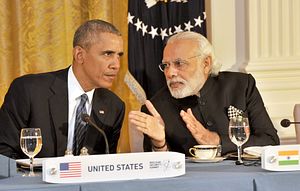As the United States undergoes a dramatic political transition with Donald Trump assuming the nation’s presidency on January 20, India is probably one of the few countries that remains relatively nonchalant about this change. There is a sense both in Washington and New Delhi that India-U.S. relations today are reasonably strong such that a change of guard in the White House will only pose transitory challenges. Moreover, Trump has so far indicated that he remains well disposed towards India. On the two key challenges facing India – China and Pakistan – Trump’s rhetoric so far is largely in tune with Indian concerns.
While there are a range of structural and institutional factors that are responsible for this remarkable turnaround in India-U.S. ties, a significant role in this transformation has been played by Indian Prime Minister Narendra Modi’s pro-active outreach to the United States ever since coming to power in May 2014. Along with my colleague at the Observer Research Foundation, Yogesh Joshi, I examine this theme in a new paper in the most recent issue of International Affairs.
Since the end of the Cold War, successive Indian governments have signaled a commitment to a robust partnership with the United States. The growth in India-U.S. relationship in the last quarter of a century is therefore a secular trend. Yet, in his first two years at the helm since May 2014, Modi has brought about a qualitative change in the India-U.S. relationship. From resolving the prickly issue of civil nuclear energy cooperation to a significant upgrade in defense cooperation as well as arriving at a common understanding on various international issues, bilateral ties seem to have acquired a momentum few had anticipated when Modi took office.
This is a remarkable development for two reasons. First, in the last few years of Modi’s predecessor, Manmohan Singh, India-United States relations seemed adrift. Second, since 2005, Narendra Modi had been denied a visa by the U.S. government due to his alleged involvement in the 2002 Gujarat riots. Therefore, an impression lingered in India that the visa issue may cast a shadow on India-US ties if a Bharatiya Janata Party (BJP) government led by Modi were to come to power at the center. Modi’s foreign policy has been able to overcome both these challenges.
Our paper examines the transformation in India-U.S. relations in the first two years of the Modi government. We discuss the state of India-U.S. relations before Modi’s ascent to the nation’s prime ministership in May 2014. The challenges confronting the relationship, however, were not strictly bilateral: Modi’s image and historical baggage had also made them personal. Political dexterity, however, has allowed Modi, as prime minister, to navigate the many pitfalls in India’s relationship with the United States. Subsequently, we elaborate on the significant progress made in the bilateral relationship in the first two years of the Modi government. We explain the rationale behind Modi’s outreach to the United States. Three factors appear to have had a significant influence: a conviction that India’s developmental priorities cannot be met without substantive cooperation with the United States; the strong, central political authority Modi enjoys within his own party and in the Indian Parliament; and lastly, the structural changes in India’s security environment brought about by an aggressive China and its growing strategic convergence with Pakistan.
As a consequence of Modi’s leadership, his personal conviction, as well as the demands of changing regional balance of power, India has significantly expanded the scale and scope of its bilateral engagement with the United States. The resolution of bilateral differences with the United States by the Modi government has signaled not only its pragmatism, but also its ideological commitment to an India-U.S. strategic partnership hitherto missing. This signaling about of the importance of the India-United States partnership in the Indian foreign policy matrix is the most important change the Modi government has ushered in India’s U.S. policy, which has so far remained constrained by the burden of ‘non-alignment.’ Modi’s success or failure in reconfiguring bilateral ties with Washington will determine the future trajectory of Indian foreign policy in more ways than one.

































